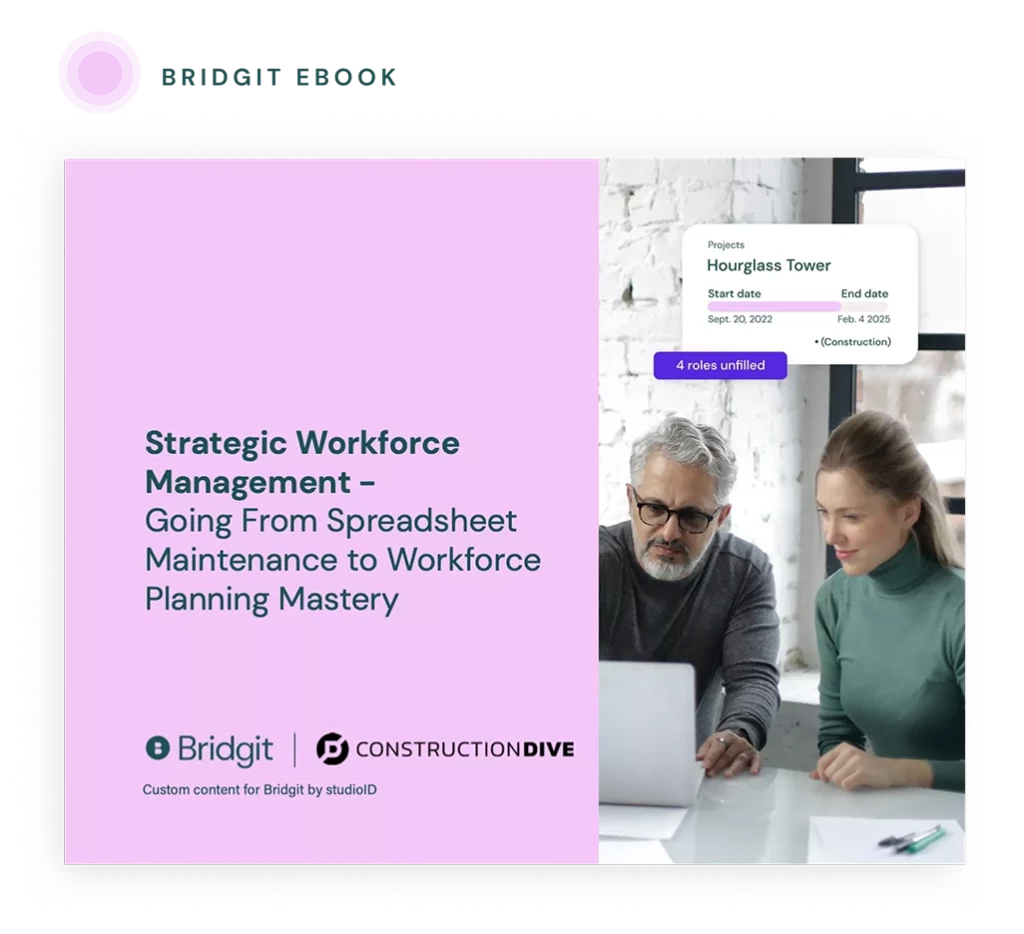Strategic investments in human capital can yield unparalleled returns in the worker-driven industry that is construction. Keep reading to learn more about these benefits.
Table of Contents
First, however, let’s discuss how construction companies of all sizes make human resources investments.
How do you invest in human capital?
Training
Training and education are among the most important investments in human capital construction companies can make. It’s also one of the most crucial parts of the human capital planning process.
After all, the industry is very process and task-driven. When implemented correctly, new strategies and technologies can save companies tremendous amounts of money. That implementation often begins with training. Speaking of training, check out our top certifications for construction career development.
Strategic hiring
A construction company’s workforce can make or break its profitability. Therefore, hiring the right people is ultimately a crucial investment in human capital.
Check out this article for more tips on making effective hiring decisions as a construction company.
Software
Software drives the modern construction industry, helping companies streamline processes and visualize data more accurately.
Because these programs ultimately save workers time and help them improve their jobs, savvy companies typically see them as investments in human capital.
Bridgit Bench is a particularly powerful human resources investment. With it, construction companies achieve optimal workforce management flows. The tool places key human capital-related data (such as workforce utilization rates) within a few clicks, allowing managers to make confident staffing decisions.
Incentives
Incentives can be very powerful to improve human capital’s productivity and retain top talent.
They come in many forms, including:
- bonuses tied to certain milestones
- worker benefits
- competitive wages
Used correctly, these incentives can deliver benefits well above the associated costs.

Looking to be more strategic with your people?
We partnered with Construction Dive to outline the steps any contractor can take to be more strategic with their workforce management.
10 Benefits of human capital investments in construction
While investments in human capital can offer tremendous benefits, there’s no denying the often high financial costs. With some human resources investments, companies also risk competing firms reaping the rewards if employees jump ship.
The following benefits of human capital investments provide insight into why construction companies are often willing to accept these risks.
1. Improved employee retention rates
According to statistics compiled by Autodesk, construction faces an industry-wide turnover rate of 21.4%. That’s among the highest rates across the entire economy.
Further, according to Edubirdie, the cost of turnover is often as high as 20% of the departing individual’s base salary.
It should come as no surprise that improving employee retention rates is a top priority among many construction management professionals. Investments in human capital can help achieve this.
After all, according to research by the Society for Human Resource Management, more than 40% of workers cite their organization’s commitment to employee development as essential for job satisfaction.
2. Improved returns on all employee-related costs
Keeping workers on the payroll is not cheap. This article discusses construction labor costs, including wages and federal and state unemployment benefit premiums.
A noteworthy benefit of increasing human capital is that these costs will subsequently deliver even greater rewards.
Look at it this way. Investing in human capital is important because doing otherwise would be akin to buying an expensive piece of equipment and then failing to maintain it. The money you spend storing it (not to mention the equipment’s initial cost) will have diminishing returns the longer you neglect upkeep.
3. More accurate workforce data tracking
Investments in human capital force you to become a better steward of your workforce management data. After all, that data will ultimately help you identify the ideal areas in which to invest.
Better workforce data tracking will produce countless other benefits for your company’s workforce management flow.
Think your workforce planning meeting could be more productive?
Download our ebook to learn how to run efficient, effective workforce planning meetings with your team.
4. Better employee prospecting
It’s much easier to find new hires when your company is recognized within the industry as taking employee development seriously. Reputations spread especially fast in construction as it’s not uncommon for workers from several firms to talk amongst themselves on job sites.
A track record of supporting professional development may also keep you from paying higher wages than your competitors to recruit top talent.
5. Identifying future leaders
Investment in human capital is important because it helps construction companies identify workers capable of providing even greater value in other roles.
This is very difficult when workers are focused solely on fulfilling their exact job titles because time hasn’t been carved out for development.
Let’s say you’re training workers on operating a specific type of equipment. If one employee displays a natural ability to use the equipment effectively, involving them in projects that rely heavily on it may be wise.
You may not have had the opportunity to identify this worker’s skill without the investment in training.
6. Improved communication and problem-solving
Investments in human capital encourage employees to work together and identify improvements that will directly benefit them.
Those investments often prompt the opening of communication lines between departments and management levels, allowing human capital to flow more freely within the organization.
This is especially important in construction, given that each department’s work typically either builds on or serves as a foundation for that of another. Cohesion is an asset!
7. More opportunities for advancement among marginalized community members
Workers in the construction industry come from a whole slew of different economic and social backgrounds. Sometimes, those backgrounds present disadvantages that aren’t easily overcome. This may keep workers from tapping into their full potential.
Human resources investments represent an attractive solution to this problem. They can help workers who may not have been able to receive certain training on their own before joining the company.
8. Better client management
Clients can tell when workers at your company aren’t engaged. It doesn’t paint a pleasing picture, especially when lacking human capital investments fuels high turnover rates that cause project delays and miscommunication.
Conversely, an engaged workforce will leave clients feeling confident in their decision to do business with your firm. Your staff will be more pleasant to interact with, which can even help smooth over occasional project hiccups.
9. A more positive work environment
When workers have the development tracks and tools needed to thrive, they’ll feel much better about coming to work, whether on the job site or in the office. Savvy construction management professionals recognize this as a key benefit of human capital investments. It makes workdays a little brighter while contributing to other perks (some of which we’ve already mentioned, such as improved employee retention).
Workers will also likely be more forthcoming regarding mistakes in a positive environment. This attitude among workers, in and of itself, can save a construction company tremendously.
10. Train for the exact skills you need
Every construction company has skill gaps workers won’t necessarily be capable of filling on arrival. Strategic investments in human capital allow you to train workers in those specific areas, honing your workforce into the exact crew needed to ensure your company’s success.
Human capital FAQ
What does investment in human capital mean?
Investment in human capital refers to a proactive effort to improve the skills, knowledge, and ability of your employees through direct investment. This may include investing in activities such as training, education, and development opportunities like attending an industry conference.
Why do companies invest in human capital?
Investing in human capital is a great way for companies to improve employee performance, increase productivity, and reduce turnover. In addition, you may find that investing in human capital fosters innovation and helps your company maintain a competitive advantage. Many companies use employee development to help attract and retain top talent.
What are examples of investing in human capital?
Examples of investing in human capital include paying for employees’ education, offering training workshops, providing access to online courses, creating mentorship programs, and encouraging attendance at industry conferences.
What could a business do to invest in human capital?
Your business can invest in human capital by offering training and development programs, providing tuition reimbursement for further education, and by creating a positive and supportive work environment. Initiatives like mentorship programs and leadership development courses are also excellent ways to nurture top performers.
We hope this article has helped you identify the benefits of human capital investments. To summarize, they’re equally important as equipment and business infrastructure investments. After all, your workforce is a vital part of your company’s operation.
For more workforce management tips, visit our blog.



